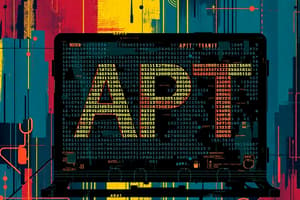Podcast
Questions and Answers
What is the second stage in the Cyber Kill Chain?
What is the second stage in the Cyber Kill Chain?
- Delivery
- Weaponization (correct)
- Reconnaissance
- Exploitation
Which cybersecurity measure involves developing a comprehensive incident response plan?
Which cybersecurity measure involves developing a comprehensive incident response plan?
- Incident response planning (correct)
- User education
- Endpoint protection
- Patch management
What is a key characteristic of Advanced Persistent Threat (APT) groups?
What is a key characteristic of Advanced Persistent Threat (APT) groups?
- Basic tactics
- Short-term access
- Non-targeted attacks
- Long-term access (correct)
What is the third stage in the Cyber Kill Chain?
What is the third stage in the Cyber Kill Chain?
What is the main purpose of continuous monitoring in cybersecurity measures?
What is the main purpose of continuous monitoring in cybersecurity measures?
What is the Cyber Kill Chain model designed to help organizations understand?
What is the Cyber Kill Chain model designed to help organizations understand?
What makes APTs difficult to detect and defend against?
What makes APTs difficult to detect and defend against?
What is the main objective of spear phishing in the context of APT groups?
What is the main objective of spear phishing in the context of APT groups?
What does the 'zero-day exploit' target in the context of APT groups?
What does the 'zero-day exploit' target in the context of APT groups?
What method do attackers use in the 'Watering Hole' technique employed by APT groups?
What method do attackers use in the 'Watering Hole' technique employed by APT groups?
Flashcards are hidden until you start studying
Study Notes
Advanced Persistent Threat (APT) and Cyber Kill Chain
Introduction
The Cybersecurity threat landscape is constantly evolving, and one of the most challenging and persistent threats is the Advanced Persistent Threat (APT). APT is a type of cyberattack that involves unauthorized access to a computer network or system to gain sensitive information. APT groups are highly skilled and well-funded, allowing them to maintain a low and slow approach for extended periods. This approach often goes unnoticed, making APTs difficult to detect and defend against. The Cyber Kill Chain is a model developed by Lockheed Martin to help organizations understand the process of a typical cyberattack and identify potential vulnerabilities.
Attack Methods Used by APT Groups
- Spear Phishing: APT groups often use spear phishing emails to trick employees into clicking on malicious links or attachments, allowing the attackers to gain access to the network.
- Watering Hole: Attackers create a fake website that appears to be trustworthy, luring users into clicking on malicious links or downloading malware.
- Zero-Day Exploit: APT groups sometimes target zero-day vulnerabilities, which are unknown to the software vendor. This makes it difficult for security teams to detect and prevent these attacks.
Stages of the Cyber Kill Chain
The Cyber Kill Chain model consists of seven stages that describe the process of a typical cyberattack:
- Reconnaissance: Attackers gather information about the target network, such as IP addresses and installed software.
- Weaponization: Attackers create a payload, often malware, to exploit vulnerabilities in the target system.
- Delivery: The payload is delivered to the target system, often through email or a website.
- Exploitation: Attackers use the payload to exploit vulnerabilities in the target system, gaining access.
- Command and Control (C&C): Attackers establish a connection to the target system, allowing them to control it remotely.
- Actions on Objectives: Attackers perform their intended actions, such as stealing data or disrupting services.
- Exfiltration: Attackers transfer the stolen data to their own systems or networks.
Characteristics of Advanced Persistent Threat (APT)
- Long-term access: APT groups maintain access to the target system for an extended period, often for months or years.
- Multiple entry points: APT groups often use multiple entry points to gain access to the target system, making it difficult to detect and prevent the attack.
- Advanced tactics: APT groups use advanced tactics, techniques, and procedures (TTPs) to evade detection and maintain access to the target system.
- Targeted attacks: APT groups often target specific organizations or individuals, requiring extensive research and planning.
Cybersecurity Measures to Counter the Cyber Kill Chain
Organizations can take several measures to counter the Cyber Kill Chain and defend against APTs:
- Implement security controls: This includes firewalls, intrusion detection systems, and network segmentation to limit the attack surface and detect potential threats.
- User education: Regular training for employees to recognize and avoid falling victim to spear phishing and other social engineering attacks.
- Patch management: Regularly updating software and operating systems to address known vulnerabilities.
- Incident response planning: Developing a comprehensive incident response plan to quickly identify and contain potential threats.
- Continuous monitoring: Regularly monitoring network activity to identify unusual patterns or behavior that could indicate an APT attack.
Defense Strategies Against APT
- Endpoint protection: Implementing endpoint protection solutions to detect and block APT malware and other threats.
- Threat intelligence: Using threat intelligence feeds to stay informed about emerging APT threats and tactics.
- Behavioral analytics: Implementing behavioral analytics tools to detect unusual activity on the network.
- Deception technologies: Deploying deception technologies to lure attackers into irrelevant or misleading targets.
- Continuous security testing: Regularly testing the security posture of the organization to identify vulnerabilities and improve defenses.
In conclusion, understanding the Cyber Kill Chain and the characteristics of APTs is crucial for organizations to develop effective defense strategies. By implementing the appropriate cybersecurity measures and defense strategies, organizations can better protect themselves against APTs and other cyber threats.
Studying That Suits You
Use AI to generate personalized quizzes and flashcards to suit your learning preferences.




